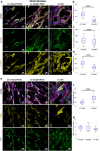Spontaneous Crimping of Gelatin Methacryloyl Nanofibrils Induced by Limited Hydration
- PMID: 40679322
- PMCID: PMC12344688
- DOI: 10.1021/acsbiomaterials.5c00828
Spontaneous Crimping of Gelatin Methacryloyl Nanofibrils Induced by Limited Hydration
Abstract
The crimped appearance of native collagen fibrils in youthful tissues serves as a mechanical buffer and phenotype determinant for resident cells. In vitro platforms emulating these native crimped networks facilitate the study of cell-matrix dynamics in various pathophysiological contexts. However, creating fibrillar networks with sizes and crimping matching native tissues using collagen-derived substrates remains challenging. We present an innovative approach to produce spontaneous, tunable crimping of electrospun, aligned gelatin methacryloyl nanofibrils using limited hydration. The diameter of the synthesized fibrils approximated that of native fibrils. Beyond individual fibril crimping, the network exhibited large-scale, periodic crimping with wavelengths matching native collagen networks. Tensile stress tests revealed that crimping reduced network stiffness but enhanced stretchability, consistent with native tissues. Additionally, crimping promoted cell translocation into the network. Fibroblasts cultured on crimped fibrils showed smaller cell areas, higher vinculin and α-tubulin expression, and lower α-smooth muscle actin levels compared to those on straight fibrils. This novel method not only replicates the native fibril characteristics using collagen-derived materials, but also offers a valuable tool for advancing our understanding of cell-matrix interactions, with significant implications for tissue engineering and regenerative medicine.
Keywords: 3D cell culture; Collagen derivatives; GelMA; fibril crimping; tissue scaffold.
Figures










Similar articles
-
Integration of co-culture conditions and 3D gelatin methacryloyl hydrogels to improve human-induced pluripotent stem cells-derived cardiomyocytes maturation.Front Bioeng Biotechnol. 2025 Jul 14;13:1576824. doi: 10.3389/fbioe.2025.1576824. eCollection 2025. Front Bioeng Biotechnol. 2025. PMID: 40727646 Free PMC article.
-
Prescription of Controlled Substances: Benefits and Risks.2025 Jul 6. In: StatPearls [Internet]. Treasure Island (FL): StatPearls Publishing; 2025 Jan–. 2025 Jul 6. In: StatPearls [Internet]. Treasure Island (FL): StatPearls Publishing; 2025 Jan–. PMID: 30726003 Free Books & Documents.
-
An in vitro model to measure the strength and stiffness of the extracellular matrix synthesized de novo by human fibroblasts.In Vitro Model. 2025 Mar 7;4(1):59-69. doi: 10.1007/s44164-025-00081-y. eCollection 2025 Feb. In Vitro Model. 2025. PMID: 40160211
-
The Black Book of Psychotropic Dosing and Monitoring.Psychopharmacol Bull. 2024 Jul 8;54(3):8-59. Psychopharmacol Bull. 2024. PMID: 38993656 Free PMC article. Review.
-
Maternal and neonatal outcomes of elective induction of labor.Evid Rep Technol Assess (Full Rep). 2009 Mar;(176):1-257. Evid Rep Technol Assess (Full Rep). 2009. PMID: 19408970 Free PMC article.
References
-
- Gathercole L., Keller A.. Crimp morphology in the fibre-forming collagens. Matrix. 1991;11(3):214–234. doi: 10.1016/S0934-8832(11)80161-7. - DOI - PubMed
- Gruber H. E., Hanley E. N. Jr.. Observations on morphologic changes in the aging and degenerating human disc: secondary collagen alterations. BMC Musculoskeletal Disord. 2002;3(1):9. doi: 10.1186/1471-2474-3-9. - DOI - PMC - PubMed
-
- Hansen K. A., Weiss J. A., Barton J. K.. Recruitment of tendon crimp with applied tensile strain. J. Biomech. Eng. 2002;124(1):72–77. doi: 10.1115/1.1427698. - DOI - PubMed
- Rigby B. J., Hirai N., Spikes J. D., Eyring H.. The mechanical properties of rat tail tendon. J. Gen. Physiol. 1959;43(2):265–283. doi: 10.1085/jgp.43.2.265. - DOI - PMC - PubMed
MeSH terms
Substances
LinkOut - more resources
Full Text Sources
